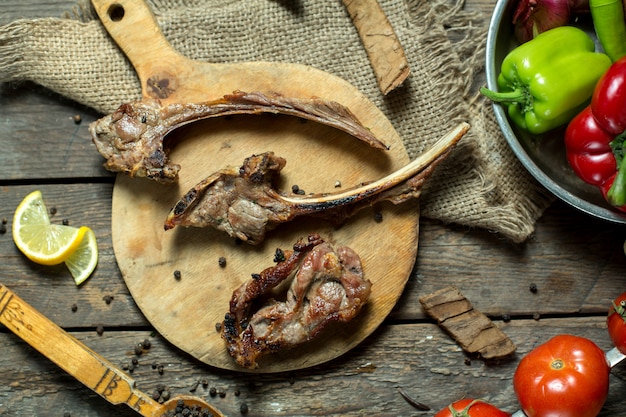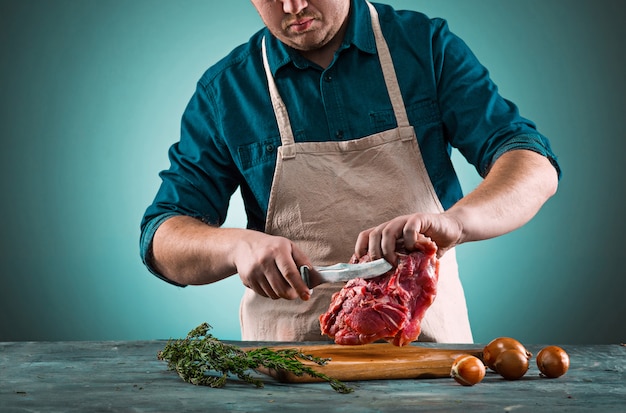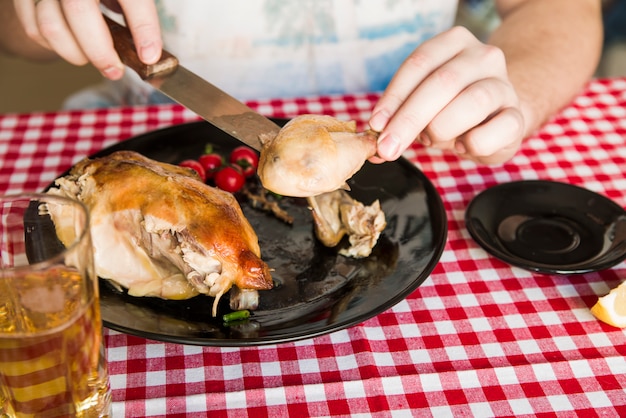Alright, let's talk venison! More specifically, we're diving deep into the world of deer backstrap. I've been a hunter for years, and there's simply nothing like the thrill of a successful hunt. But, the real reward, the real magic, comes when you get to cook that prize meat. And let me tell you, there's no better cut than the backstrap. It's lean, tender, and bursting with flavour. But if you're a newcomer to the venison game, cooking it might seem a bit intimidating. Well, fear not! I'm here to guide you through every step, from the moment you bring that backstrap home to the final, glorious bite. This guide is packed with tips, tricks, and a whole lot of experience, ready to transform you into a venison-cooking master.
(Part 1) The Hunt and the Haul

Let's start with the hunt itself. Now, I'm not going to delve into the details of hunting techniques – that's a whole other story for another time. But, once you've managed to bag that beautiful buck, the real work begins. After the initial field dressing, it's all about focusing on that backstrap. This cut is a true prize, running along the spine, from the neck down to the tail. It's consistently the most tender and flavorful part of the deer. The key here is to be swift and efficient in your processing.
A Step-by-Step Approach
Back at the cabin or your kitchen, you've got to get that backstrap ready for the cooking magic to happen. Here's how to do it right:
- Skinning: You can skin the backstrap right away, or wait until it's been chilled. Use a sharp knife and be sure to work carefully, avoiding any unnecessary damage to the meat.
- Trimming: This is the crucial step for removing any excess fat or connective tissue. Keep the backstrap nice and clean, folks. This helps ensure even cooking and stops that "gamey" taste from creeping in.
- Storing: This part is absolutely crucial. Refrigerate that backstrap as soon as you can. If you’re planning to cook it later, wrap it tightly to prevent it from drying out. Freezing is an option, but make sure you use proper vacuum sealing techniques for optimal quality when it's time to cook.
(Part 2) The Butcher's Touch

Alright, you've got that beautiful backstrap, ready to go. But how do you handle this unique cut? Here's the deal: deer backstrap is inherently lean, so you need to use cooking methods that bring out those natural flavours without drying it out.
Tenderize and Enjoy
Tenderizing is crucial with deer backstrap. Here's how I do it:
- Marinate: This is where the magic truly happens. I've tried countless marinades over the years, but here's what consistently delivers the best results: olive oil, lemon juice, soy sauce, garlic, herbs (like rosemary or thyme), and a hint of honey or maple syrup. Just a few hours in this marinade will make a world of difference.
- Butterfly: This technique opens up the backstrap, making even cooking a breeze and creating a nice, flat surface for grilling or pan-frying. Make a lengthwise cut down the center, but don't cut all the way through. Open it up like a book and flatten it out.
- Pound It Out: Now, use a meat mallet to gently pound the backstrap to even out the thickness. This helps prevent uneven cooking and ensures a more tender texture.
(Part 3) cooking techniques

Alright, here's the exciting part! It's time to cook that deer backstrap. There are a few techniques I absolutely swear by, each offering its own unique flavour profile and texture.
Grill It Up!
For me, grilling is the ultimate way to cook deer backstrap. The smoky aroma, the beautiful char, it's simply unbeatable. Here's the lowdown:
- Hot and Fast: A high-heat grill is your best friend. Preheat it to around 450°F (230°C).
- Seasoning: Keep it simple, folks. A basic salt and pepper rub, or maybe a touch of garlic powder, is all you really need.
- cooking time: You want your deer backstrap medium-rare to medium. For a medium-rare cook, about 3-4 minutes per side should do the trick. For medium, aim for 5-6 minutes per side.
- Rest: After cooking, let the backstrap rest for about 5-10 minutes before slicing. This allows the juices to redistribute, ensuring a super tender and flavorful cut.
Pan-Fried Perfection
If you don't have a grill handy, or it's a chilly day, pan-frying is a great alternative.
- Heat It Up: Grab a heavy-bottomed pan, and heat it over medium-high heat. Add a good amount of oil, enough to coat the bottom of the pan.
- Sizzle Away: Now, carefully place your backstrap in the hot pan. Avoid overcrowding the pan, so you get a nice sear. Cook for about 3-4 minutes per side for medium-rare, or 4-5 minutes per side for medium.
- Rest and Serve: After cooking, let the backstrap rest for a few minutes before slicing. This is absolutely essential for keeping those juices locked in.
Oven-Baked Goodness
For a more hands-off approach, oven-baking is a great choice. It's also perfect for cooking larger backstraps.
- Preheat: Preheat your oven to 350°F (175°C).
- Seasoning: Season the backstrap with your favorite herbs and spices. You can even use a pre-made marinade.
- Baking Time: The exact time depends on the size and thickness of the backstrap, but aim for around 20-30 minutes for medium-rare. Use a meat thermometer to check the internal temperature. It should read 130°F (54°C) for medium-rare.
- Rest and Slice: As always, let the backstrap rest for a few minutes before slicing.
(Part 4) side dish Delights
Okay, you've cooked the perfect deer backstrap. Now, what about those sides? Venison pairs beautifully with a variety of flavors. Here are some ideas that I've found to be particularly perfect:
Classic Combos
- Roasted Root Vegetables: Think carrots, parsnips, sweet potatoes. Toss them with olive oil, herbs, and salt and pepper, and roast until tender and caramelized. The sweetness of these roasted vegetables complements the gamey flavor of venison in a truly delightful way.
- Creamy Polenta: A timeless classic pairing! Creamy polenta, seasoned with Parmesan cheese and a touch of butter, provides a comforting contrast to the rich, savory venison.
- Wild rice pilaf: The nutty flavor of wild rice is a natural match for venison, and it's packed with nutrients. Simply sauté some onion and garlic, then add the rice and broth, and simmer until the liquid is absorbed.
Going Beyond the Basics
Feeling adventurous? Here are some other side dish ideas that you might not expect, but trust me, they work wonders:
- Apple and Cranberry Chutney: The sweet and tangy flavor of this chutney cuts through the richness of the venison and adds a refreshing burst of flavor.
- Sautéed Mushrooms and Onions: A simple but incredibly delicious side. Sauté some sliced mushrooms and onions in butter or olive oil, and season with salt and pepper. The earthy flavor of the mushrooms is a natural complement to venison.
- roasted brussels sprouts: Don't shy away from this one! Roasting Brussels sprouts with a touch of bacon and maple syrup brings out their natural sweetness and adds a smoky depth of flavor that pairs beautifully with venison.
(Part 5) Sauces and Glazes
Let's talk about adding another layer of flavor to your deer backstrap. A good sauce or glaze can take your dish from good to truly extraordinary. Here are some of my tried and true favorites:
Classic Venison Sauce
This is a simple sauce that always impresses. It's rich, savory, and complements venison beautifully. Here's what you'll need:
- Ingredients:
- 1 tablespoon butter
- 1 tablespoon flour
- 1 cup beef broth
- 1/4 cup red wine (optional)
- 1 teaspoon Worcestershire sauce
- Salt and pepper to taste
- Instructions:
- Melt the butter in a saucepan over medium heat.
- Whisk in the flour and cook for 1 minute, stirring constantly.
- Gradually whisk in the beef broth and red wine (if using).
- Bring the sauce to a simmer, and cook for 5 minutes, or until thickened.
- Stir in the Worcestershire sauce and season with salt and pepper to taste.
Blackberry Glaze
If you're craving something a little sweeter, a blackberry glaze is a fantastic choice. Here's how to make it:
- Ingredients:
- 1 cup fresh blackberries
- 1/2 cup balsamic vinegar
- 1/4 cup brown sugar
- 1 tablespoon Dijon mustard
- Instructions:
- Combine the blackberries, balsamic vinegar, brown sugar, and Dijon mustard in a saucepan.
- Bring the mixture to a boil over medium heat, then reduce the heat to low and simmer for 10 minutes, or until the glaze has thickened.
- Use a potato masher to crush the blackberries in the glaze.
- Strain the glaze through a fine-mesh sieve to remove the seeds.
Cherry Port Reduction
This sauce is rich, fruity, and pairs exceptionally well with venison. Here's the recipe:
- Ingredients:
- 1 cup pitted cherries
- 1/2 cup port wine
- 1/4 cup brown sugar
- 1 tablespoon balsamic vinegar
- Instructions:
- Combine the cherries, port wine, brown sugar, and balsamic vinegar in a saucepan.
- Bring the mixture to a boil over medium heat, then reduce the heat to low and simmer for 15 minutes, or until the sauce has thickened.
- Use a potato masher to crush the cherries in the sauce.
- Strain the sauce through a fine-mesh sieve to remove the seeds.
(Part 6) The Finishing Touches
Alright, your backstrap is cooked to perfection, your sides are ready, and your sauce is simmering beautifully. Now, it's time to bring it all together and make this meal truly unforgettable.
Plating with Flair
Presentation matters, folks! Here's how I like to plate my venison backstrap:
- Slicing: Slice the backstrap thinly across the grain. This ensures that each bite is tender and flavorful.
- Arrangement: I like to arrange the sliced backstrap on a bed of your chosen side dish.
- Sauce Drizzle: Drizzle your chosen sauce over the backstrap, making sure to distribute it evenly.
- Garnish: Finish with a simple garnish, like fresh herbs (parsley, rosemary, or thyme), a sprinkle of toasted nuts, or a drizzle of olive oil.
Don't Forget the Wine Pairing
For a complete dining experience, you need the perfect wine pairing. Venison's gamey flavor calls for a wine with structure and tannins. Here are some of my favorites:
- Pinot Noir: The fruit-forward flavors and earthy notes of Pinot Noir complement the richness of venison beautifully.
- Syrah/Shiraz: These wines offer bold tannins and rich fruit flavors that stand up to the venison's gamey flavor.
- Zinfandel: A spicy and fruity wine with good tannins, Zinfandel is a great choice for venison, especially if you’re serving it with a blackberry glaze or cherry port reduction.
- Bordeaux: A classic pairing for venison, Bordeaux offers complex aromas and flavors, along with enough tannins to stand up to the gamey flavor of the meat.
(Part 7) Leftover Love
You've cooked up a feast, but there's always a chance you'll have leftovers. Don't let that delicious venison go to waste! Here's what you can do:
Day-After Delights
- Venison Salad: Slice leftover backstrap into thin strips and add it to your favorite salad. The protein and flavor of the venison will make your salad a meal.
- Venison Sandwiches: Thinly slice leftover backstrap and use it for delicious sandwiches. Try pairing it with some sharp cheddar cheese, arugula, and a touch of mustard.
- Venison Quesadillas: This is a great way to use up leftover backstrap and cheese. Just layer the ingredients on a tortilla and grill until golden and crispy.
- venison chili: You can add the leftover backstrap to a pot of chili for extra flavor.
(Part 8) Tips and Tricks
Alright, here are some final tips to ensure your deer backstrap cooking is a smashing success. These are tricks I've learned through years of trial and error, so pay close attention!
Mastering the Meat
- Don't Overcook It: Remember, venison is lean and can dry out easily. Aim for medium-rare to medium for the best texture and flavor.
- Rest, Rest, Rest: Let your backstrap rest for 5-10 minutes after cooking. This allows the juices to redistribute, making it more tender.
- Don't Be Afraid of Fat: A little bit of fat can make a big difference in flavor and texture. If you trim the backstrap too lean, it might be dry.
- Use a Meat Thermometer: This is the best way to ensure your backstrap is cooked to your liking.
Beyond the Basics
- Freezing Venison: If you’re freezing your backstrap, make sure to vacuum seal it to prevent freezer burn.
- Don't Be Afraid to Experiment: Try different marinades, sauces, and side dishes to find what you like best.
- Enjoy the Process: cooking venison is a rewarding experience. Take your time, be patient, and enjoy the process!
(Part 9) FAQs
I know you might have some questions about cooking deer backstrap. Here are some common ones, and I'll give you my honest answers.
What if my venison tastes "gamey"?
If your venison has a strong gamey flavor, it's often because the meat wasn't handled properly or it was aged too long. Marinate the backstrap for several hours in a mixture of acidic ingredients like lemon juice, vinegar, or wine. This will help to tenderize the meat and neutralize some of the gamey flavor.
How long does venison last in the fridge?
Fresh venison can last in the fridge for 3-5 days. If it's been frozen, it can last for 6-12 months. Make sure to thaw it properly in the refrigerator before cooking.
What's the best way to tell if venison is cooked properly?
The best way to tell if venison is cooked properly is to use a meat thermometer. Aim for an internal temperature of 130°F (54°C) for medium-rare, 140°F (60°C) for medium, and 150°F (65°C) for medium-well. You can also check for doneness by pressing on the meat. If it's springy to the touch, it's cooked.
What are some good ways to serve venison besides grilling?
There are many ways to cook venison besides grilling. You can pan-fry it, bake it, or even slow-cook it. Get creative and experiment with different cooking methods to find what you like best.
Can I use other cuts of venison besides backstrap?
Absolutely! You can use other cuts of venison, such as tenderloin, sirloin, and even venison roast. Just remember that different cuts will require different cooking times and techniques.
So there you have it! Your ultimate guide to cooking a delicious deer backstrap. Get out there, grab your hunting gear, and prepare to enjoy the fruits of your labor. Remember, patience, a bit of practice, and a love for good food are all you need to become a venison master. Happy hunting and happy eating!
Everyone is watching

Prime Rib Roast Cooking Time Chart: Per Pound Guide
Cooking TipsPrime rib roast. Just the name conjures images of lavish dinners, crackling fires, and hearty laughter. It’s ...

How Long to Bake Potatoes in the Oven (Perfect Every Time)
Cooking TipsBaked potatoes are a staple in my kitchen. They're incredibly versatile, delicious, and surprisingly easy to m...

Perfect Rice Every Time: The Ultimate Guide to Cooking Rice
Cooking TipsAs a self-proclaimed foodie, I've always been a bit obsessed with rice. It's the foundation of countless cuisi...

The Ultimate Guide to Cooking Asparagus: Tips, Techniques, and Recipes
Cooking TipsAsparagus. The mere mention of this spring delicacy conjures up images of vibrant green spears, crisp and burs...

Ultimate Guide to Cooking the Perfect Thanksgiving Turkey
Cooking TipsThanksgiving. Just the word conjures up images of overflowing tables laden with delicious food, the scent of r...
